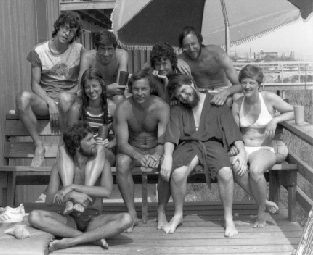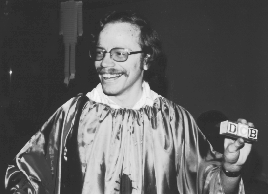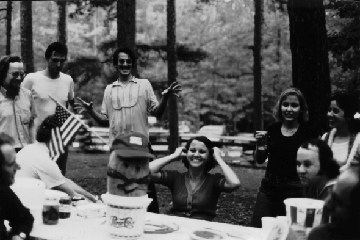
Charlie Gunn, Mike Holder, Jane Gambill, Scott Hennes, Jenny Longstaff, Brian Van Duzee, Wm Leler, Teresa McBennett, and Larry Lifshitz at Emerald Isle in 1982. (Photo: © Department of Computer Science, UNC-Chapel Hill) |
The Department as a social unit would make a fine laboratory for a
sociologist. We began as one small, happy family. We grew through a
period of being too large for one family but too small for several.
At the same time, our physical spaces expanded from concentration chiefly
in one location to the diversity of six buildings. As we grew, there was
a tendency to become a collection of small, happy families. That tendency
was never entirely successful, and in the process many of us lost sight of
the enterprise as a whole. Students in a research group in one building
might not even recognize students from a different building.
|
HumorAny healthy organization has its humor. To me, three examples stand out. One morning there appeared on the New West bulletin board a page from the doctoral thesis of one E. Clipse, the creation of graduate students Lee Brown and Paul Clements. Dr. Clipse kept entertaining us with assorted writings, and the pen name was later adopted by some other students, as well as by Fred Brooks and Dave Parnas. |

Steve Bellovin as D.C. Block at the 1976 Halloween party. (Photo: Mike Pique, © Department of Computer Science, UNC-Chapel Hill) |
|
Another was the set of SACM Newsletter articles signed by D. C. Block.
I should point out, for readers mercifully unfamiliar with IBM's OS/360
operating system, that one of its key features was the Data Control
Block (DCB). The author of those articles was graduate student Steve
Bellovin. He, Brown, and Clements have consented to become unmasked
for this history. So has Dr. Clipse, whose permission was forwarded
by a reliable source. More irreverent humor was embodied in the unofficial songs of the Department, most of them introduced at two Pizer Punch Parties and at one picnic. Among the authors were graduate students Steve Bellovin, Geoff Frank, Dave Kehs, Jim Lipscomb, and Mike Pique. My panel of reviewers agrees that the Colloquium Gavotte by Kehs was the pick of the songs, even though it did sling a sharp barb at me. All three of these manifestations of humor peaked in the late 1970s and early 1980s. Soon thereafter, under the impetus of the second review of the graduate programs, the Department started to take its research very seriously. I sometimes wonder whether it also began to take itself very seriously.
LabsBy far the oldest identifiable laboratory in the Department is the Graphics and Imaging Lab. Long known as the G-Lab, it was created initially in the late 1960s by the installation of the IBM 2250 graphics engine in borrowed space in Phillips Hall. It has continued to expand to where it and its sublaboratories occupy much of the central core area of Sitterson Hall's level 2.The Microelectronics Design Lab (MDL) was established with MCNC assistance in 1980. Its goal was to facilitate the design of microelectronic systems, particularly the chips. Its functions have gradually migrated into the individual design teams, and the MDL was dissolved in Spring 1993. The Microelectronic Systems Lab (MSL) provides facilities for building prototypes of a variety of microtechnology-based systems to support research in the application of information processing in a multidisciplinary context. Established in 1981, it has become an exceptional academic prototyping laboratory. The Software Systems Lab (SoftLab) was created in August 1983 with funding from our first infrastructure grant. Its purpose was to support experimentation in software systems, rapid software prototyping, and software for experimental machine architectures. It was also responsible for "productizing" our software for distribution to other organizations. After funding ran out, it ceased operation in September 1993.
|
|
The TextLab had focused since around 1985 on natural language analysis
and retrieval systems, hypertext, and studies of users' cognitive
behavior and strategy. Aided by ONR and NSF funding, we had begun in
Fall 1989 to build a faculty presence in distributed systems. By
incorporating these new faculty, the TextLab evolved in 1990-91 into
the Collaboratory, working on group collaboration and on collaboration
support systems. Within the Collaboratory exists also the DIRT
(DIstributed and Real Time systems) group, established in Fall 1990.
It operates the Multimedia Networking Lab for the study of operating
system and network support for continuous media, particularly digital
audio and video. The Vision and Human-Computer Interaction Lab, established in October 1992, provides facilities for conducting research and performing visual experiments by Department researchers and by collaborators from several other departments.
|

Next Section: "Conclusion"John Colotta, Kathy Yount, Lydia Papanikolaou, Paul Clements, and Vicki Baker, among others at the 1979 Fourth of July Department picnic. (Photo: Mike Pique, © Department of Computer Science, UNC-Chapel Hill)